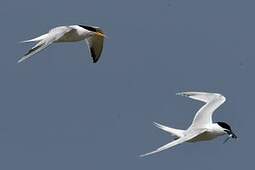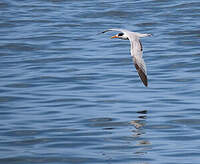Elegant Tern
Thalasseus elegans - Sterne élégante
Identification
This medium-sized Elegant Tern has a long orange bill, a black cap, and a fluffy nape. The upperparts are light grey and the underparts are mostly white, sometimes with pinkish tints in the belly feathers. Legs are black. The Elegant Tern looks very similar to the Royal Tern, but can be identified by its longer, narrower and slightly curved bill often with brighter orange color, and by its more ragged crest. In breeding plumage the forehead is white and there is no white eye-ring. Juveniles have paler upperparts with scaly grey pattern. It can be distinguished from its close relatives by some features, such as a less ragged crest than the Crested Tern, a little paint black in front of the eye, a slight more slender and slim-looking shape, and a bill that is less curved than the Crested Tern. It is also slightly paler overall than the Crested Tern, with a white nape (without grey).
Subspecific information monotypic species
Foreign names
- Sterne élégante,
- Charrán elegante,
- garajau-elegante,
- Schmuckseeschwalbe,
- pompás csér,
- Sierlijke Stern,
- Sterna elegante,
- aztektärna,
- Langnebbterne,
- rybár pôvabný,
- rybák západní,
- Aztekerterne,
- kaunotiira,
- Elegante Sterretjie,
- xatrac elegant,
- Skrautþerna,
- rybitwa kalifornijska,
- slaidais cekulzīriņš,
- prelestna čigra,
- Элегантная крачка,
- ユウガアジサシ,
- 美洲凤头燕鸥,
- aztektärna,
- 麗色鳳頭燕鷗,
Voice song and call
Habitat
Behaviour character trait
After the breeding season, Elegant Terns disperse northwards along the Pacific coast, in the northern parts of California, but in years when the waters are warmer they can be found as far north as Oregon, Washington or the southern coasts of British Columbia.
These terns mainly winter in South America, but in some winters a small number can be found, locally, along the northern Pacific coast (in the Mexican state of Nayarit). In Southern California, breeding success and post-breeding dispersal appear to mainly depend on oceanographic conditions, which influence the distribution of their main prey, anchovies. Elegant Terns look for food by hovering above shallow waters and then diving into the water to capture the fish. They can only carry one fish at a time across their beak. These gregarious terns call each other frequently and fish in groups.Dietfeeding habits
Reproduction nesting
This very sociable bird nests in very tight groups, often only 20 or 30 cm apart in order to limit predation by more aggressive species.
Like many terns, the nest of the Elegant Tern is simply a small scooped-out area on the ground. Incubation is probably performed by both parents. After about three weeks, the chicks hatch and remain in the nest for a few days before joining a nursery where they are still fed by their own parents. Raising the young takes six months, during which the chicks become feathered and learn to search for their own food.Geographic range
Threats - protection
IUCN conservation status
concern
in the Wild
threatened
evaluated
This species is fragile due to the fact that 90% of its population reproduces at only one site. The species undergoes huge fluctuations of its population due to climate-related events and could be negatively affected by climate change, human intrusions, and overfishing.
Sources of information
- IOC World Bird List (v15.1), Gill, F and D Donsker (Eds). 2025-12-07.
- Birds of Northern South America, an identification guide, Robin Restall, Clemencia Rodner, Miguel Lentino
Other sources of interest
 Specification sheet created on
03/08/2023 by Jean-Pierre Trouillas
Specification sheet created on
03/08/2023 by Jean-Pierre TrouillasTranslation by AI Oiseaux.net
© 1996-2025 Oiseaux.net
- Accipitriformes
- Aegotheliformes
- Anseriformes
- Apodiformes
- Apterygiformes
- Bucerotiformes
- Caprimulgiformes
- Cariamiformes
- Casuariiformes
- Charadriiformes
- Ciconiiformes
- Coliiformes
- Columbiformes
- Coraciiformes
- Cuculiformes
- Eurypygiformes
- Falconiformes
- Galliformes
- Gaviiformes
- Gruiformes
- Leptosomiformes
- Mesitornithiformes
- Musophagiformes
- Nyctibiiformes
- Opisthocomiformes
- Otidiformes
- Passeriformes
- Pelecaniformes
- Phaethontiformes
- Phoenicopteriformes
- Piciformes
- Podargiformes
- Podicipediformes
- Procellariiformes
- Psittaciformes
- Pterocliformes
- Rheiformes
- Sphenisciformes
- Steatornithiformes
- Strigiformes
- Struthioniformes
- Suliformes
- Tinamiformes
- Trogoniformes



























